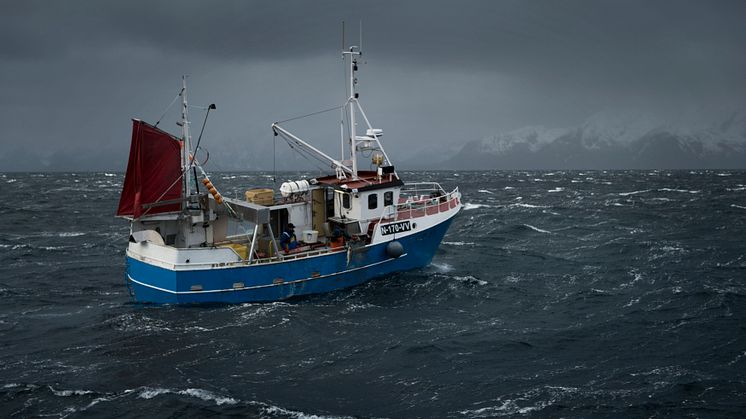
Press release -
Best month ever for fresh cod from Norway
Norway exported cod, saithe, haddock and other bottomfish worth NOK 1.3 billion in February, which is 28 per cent or NOK 284 million more than in February 2015. Record exports for fresh products and large exports of frozen cod and haddock are responsible for the growth.
"There has been a better start to the winter fishery this year than the same time last year, and with better prices and higher volumes this is the best month in history for fresh fish," says Ove Johansen at the Norwegian Seafood Council.
The total export value of all fresh codfish products amounted to NOK 543 million in February, and the value has never been higher in an individual month. This is 66 per cent or NOK 216 million more than in February 2015. Exports increased in volume by 73 per cent.
Sales of Skrei cod amounted to NOK 75.4 million, 73 per cent or NOK 32 million more than in February last year. The volume increased from 1390 tonnes to 2115 tonnes, up 52 per cent. The price increased by 20 per cent to NOK 48.73 per kg on average.
Fresh whole cod increased by 60 per cent or NOK 108 million to NOK 288 million in total. The quantity increased by 3,033 tonnes to 10,160 tonnes. Fresh whole saithe increased from 359 tonnes to 1535 tonnes, up 323 per cent.
Exports of fresh fillets amounted to NOK 84 million, 40 per cent above February last year. Fresh cod fillets went up by NOK 9.1 million to NOK 60.4 million. Fresh haddock fillets increased from NOK 8 million to NOK 20.1 million.
About half of the fresh fish from Norway goes to Denmark before it is distributed across Europe, but there was also good growth in export value to Poland (142 per cent), Spain (82 per cent) and France (44 per cent).
Good month for frozen fish
Sales of frozen codfish products increased by 44 per cent or NOK 117 million to NOK 385 million in total. Fresh whole cod was responsible for the greatest increase, from NOK 103 million to NOK 169 million. The quantity increased from 4,154 tonnes to 6,119 tonnes, up 47 per cent. The price increased by 11 per cent to NOK 27.69 per kg. The largest recipient of frozen whole codfish was China, which increased from NOK 73 million to NOK 113.8 million in February.
Frozen fillets increased from NOK 55 million to NOK 78 million in February, compared with the same month last year. More haddock has been produced, both in blocks and fillets. On average, the prices for frozen fillets increased by 14 per cent, but for blocks there was a reduction, minus 13 per cent for haddock, minus 11 per cent for saithe and minus 5 per cent for cod blocks. For fillets, the haddock price went up by 16 per cent, saithe went down by 2 per cent and cod fillets went up by 29 per cent.
The largest market for frozen fillets was the United Kingdom with a value of NOK 27.7 million, up 33 per cent from February last year.
Reduction for clipfish exports
Clipfish exports amounted to NOK 206 million in February, a decrease of 20 per cent or NOK 53 million compared with February 2015. In total, 4,833 tonnes of clipfish were exported, which is a reduction of 1,213 tonnes or 20 per cent.
Of this, NOK 96 million worth of clipfish from Atlantic cod was exported, a reduction of NOK 10 million from last year or 9 per cent. The price was on average 6 per cent higher than the price in February 2015. The value of saithe clipfish amounted to NOK 95 million, which is NOK 39 million less than in 2015. The price for saithe was 9 per cent less than the price in February 2015.
NOK 71 million worth of clipfish was sold to Portugal in February, up 20 per cent. The next largest market was the Dominican Republic with a value of NOK 44 million.
Increased salted fish exports
Exports of salted fish, both whole and fillets, increased by NOK 15 million to a total of NOK 111 million in February. The increase from 2015 was 16 per cent. The quantity of whole salted cod was reduced by 5 per cent to a total of 2134 tonnes, while at the same time the price increased on average by 13 per cent, measured in Norwegian kroner.
Salted fillets of ling increased from NOK 8.2 million to NOK 13.9 million, and both volume and price increased, by 66 per cent and 2 per cent, respectively. The largest market for salted ling fillets is Greece, which bought NOK 11.3 million worth in February, up 47 per cent from the same period last year.
Dried fish at higher price
Sales of whole dried fish amounted to NOK 55 million in February, up NOK 11 million from the corresponding month in 2015. The volume increased by 4 per cent, from 381 tonnes last year to 395 tonnes this year. The price was on average NOK 139.64 per kg, which is 19 per cent higher than in February 2015.
Sales of dried heads and other dried by-products declined from NOK 10.8 million to NOK 7.4 million in February. Prices for this category declined by 26 per cent.
The largest market was Italy, which purchased NOK 37.5 million worth of dried fish. Nigeria, as the next largest market, reduced its purchases by 43 per cent to a total of NOK 9.4 million in February.
Topics
Categories
The Norwegian Seafood Council works with the Norwegian fisheries and aquaculture industries to develop markets for Norwegian seafood through local market intelligence, market development and reputational risk management. The Seafood Council is headquartered in Tromsø and maintains local representatives in twelve of Norway's most important international markets. The Norwegian seafood industry finances the activities of the Norwegian Seafood Council via a tariff on all Norwegian seafood exports.
The Norwegian Seafood Council is a public company owned by the Ministry of Trade, Industry and Fisheries.



